At A Glance
Holiday shopping in 2025 doesn’t follow one clear pattern, with shoppers blending early planning and last-minute purchases, digital discovery and in-store validation, and cautious spending. Marketers who embrace this complexity, by staying relevant, consistent, and connected across channels, will be best positioned to win this season.Holiday shopping in 2025 feels a lot like a complicated relationship. Shoppers want deals, but they also want trust. They start shopping early, but they’re still browsing well into December. They love the convenience of online shopping, but they still show up in-store before making the final call.
Our 2025 Holiday spending trends and insights report, created this year in collaboration with GroundTruth, explores these contradictions. Our findings show that this year’s holiday season isn’t about one big shift; it’s about managing the push and pull between what consumers say, what they do, and how marketers respond.
Here are three complicated truths you need to know.
Experian’s 2025 Holiday spending trends and insights report
Optimize your 2025 holiday shopping campaigns with our latest report with GroundTruth.
Download now1. The new rules of holiday timing
Almost half (45%) of consumers plan to start shopping before November, but 62% admit they’ll still be buying in December. And post-holiday shopping (think gift card redemptions and deal-hunting) remains a real factor.
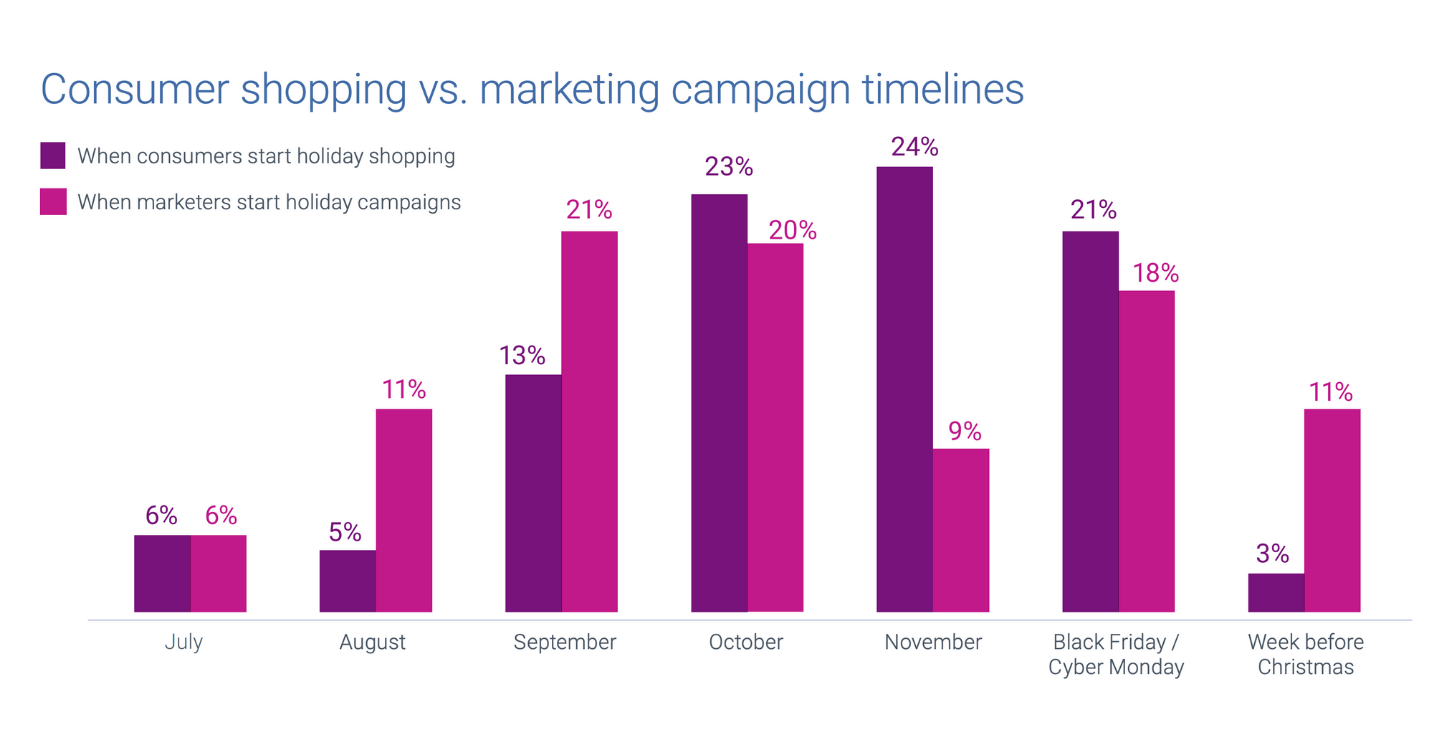
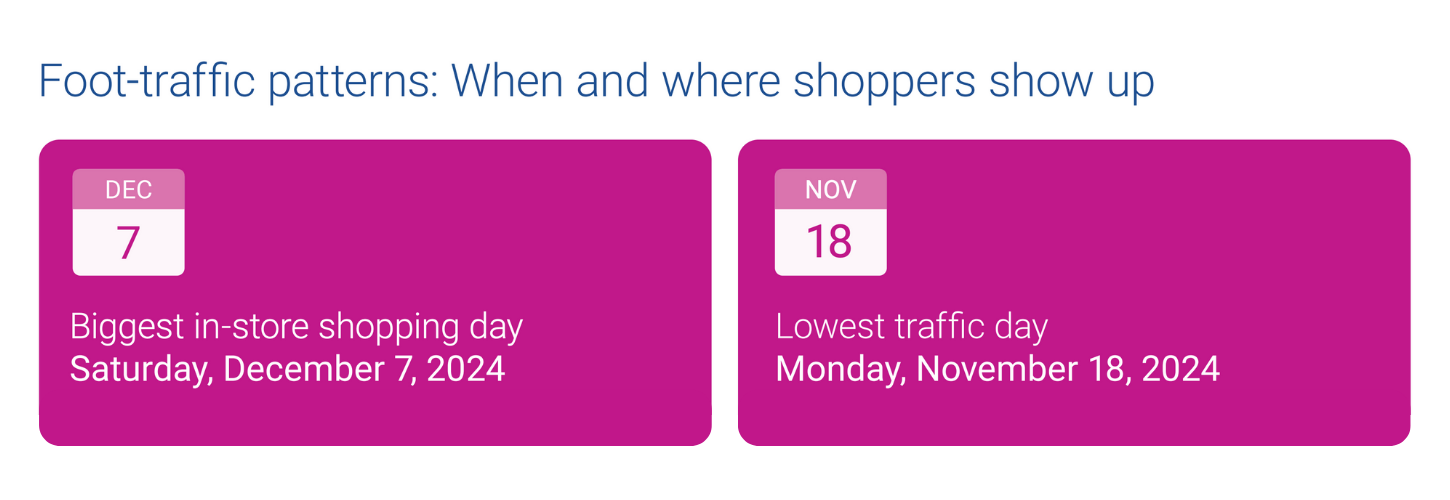
Why it’s complicated
The holiday calendar isn’t what it used to be. There’s no single “big moment” anymore. Instead, shoppers are spreading purchases across months, peaking around the “Turkey 12” (the 12 days surrounding Thanksgiving) and again in the final December rush.
What to do about it
- Stretch your campaigns across the full season, not just Cyber Week.
- Refresh offers to stay relevant as shopper motivations change from deal-seeking to last-minute urgency.
- Watch for post-holiday momentum and extend your promotions into January.
How belVita nailed the timing
In celebration of National Coffee Day, belVita partnered with GroundTruth on a one-month campaign to boost product awareness and drive foot traffic to Target stores. By utilizing digital out-of-home (DOOH) and mobile ads powered by location, behavioral, and purchase-based targeting, the campaign achieved a 3.44% visitation rate, nearly $476k in products added to carts, and a low cost-per-visit of just $0.22.
2. Online leads, but in-store still seals the deal
Nearly 40% of shoppers say they’ll split their purchases between online and in-store and 80% of consumers still prefer the in-store experience. Only a small fraction plan to shop exclusively in one channel. That means while digital often starts the journey, the final decision often happens in a physical store.
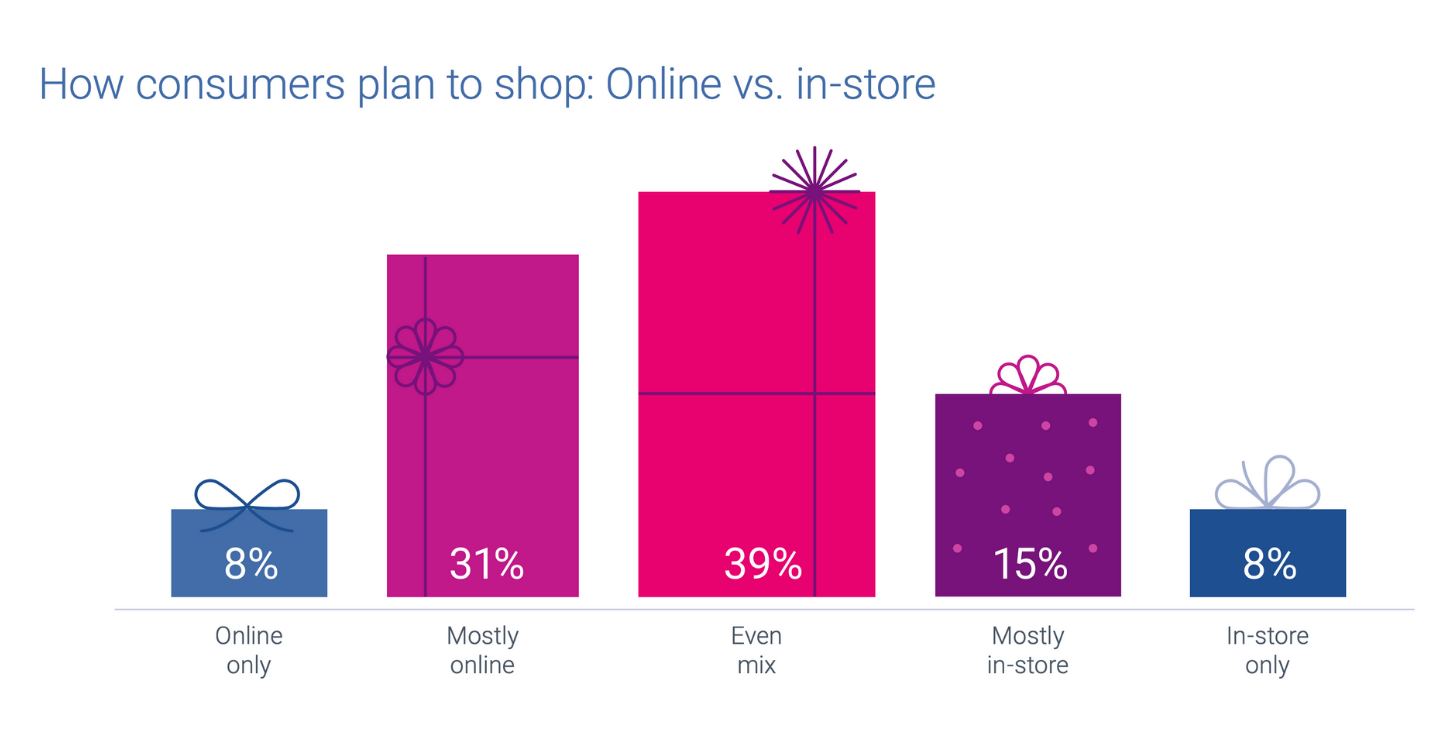
Why it’s complicated
Shoppers love the convenience of browsing online, but they still want the reassurance of seeing, touching, or testing products before buying. In-store isn’t just about the transaction, it’s the validation step.
What to do about it
- Build omnichannel strategies that connect digital discovery with in-store follow-through.
- Use location and identity data to tie digital impressions to real-world actions, like foot traffic and purchases.
- Focus on consistency: shoppers expect the same value, tone, and trust whether they’re on a website, in an app, or standing in a store aisle.
How Duke Cannon used on-premise targeting to drive sales lift
Duke Cannon, a premium men’s grooming brand, partnered with GroundTruth to launch a successful multichannel campaign utilizing location-based and behavioral audience targeting across CTV and mobile screens to drive in-store visits and sales.
By targeting consumers with mobile ads while they were physically in-store, the company capitalized on high purchase intent, aiding in the 12% sales lift. This strategic approach resulted in over 43.9k provable in-store visits and a significant increase in sales.
3. Marketers double down, consumers hold back
This holiday season, expectations are split. 66% of marketers expect holiday spend to rise, but only 22% of consumers agree. While brands are leaning into bigger investments across CTV, retail media, and social, shoppers are staying cautious, weighing value and waiting for the right deal.
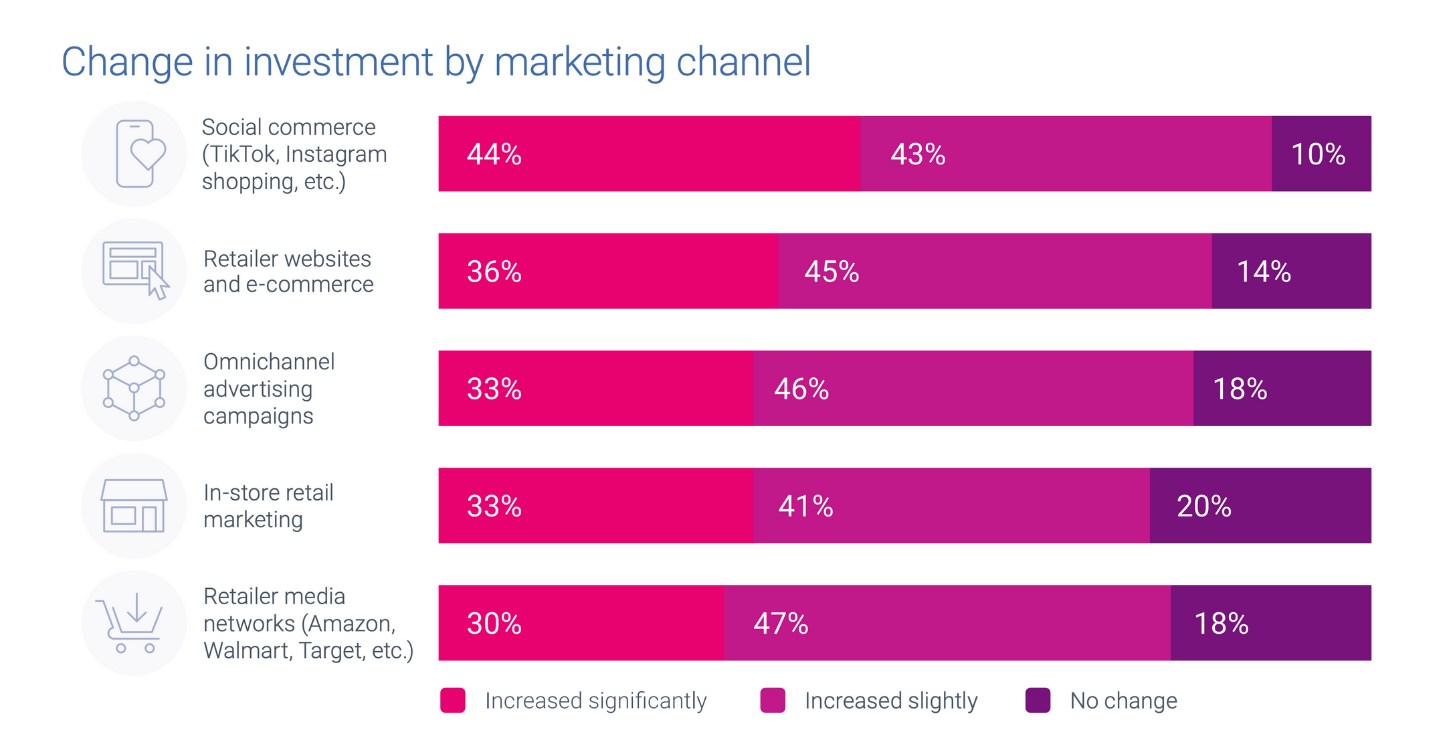
Why it’s complicated
That disconnect introduces risk. If marketers don’t align spend with real consumer behavior, budgets can get wasted in the rush to cover every channel. Shoppers haven’t stopped spending, but they’re spending differently. They’re trading down to discount and big-box retailers while cutting back in discretionary categories like apparel and restaurants.
What to do about it
- Prioritize efficiency by focusing on the right audiences, not just more impressions.
- Make consistency your advantage: reach people once and connect across platforms instead of chasing fragmented signals.
- Balance aggressive media investment with messaging that acknowledges consumer caution — shoppers want value and trust, not hype.
Measuring TV and streaming impact with iSpot
iSpot’s Audience Builder, powered by Experian’s Marketing Attributes, helps brands reach high-value audiences. During the holiday season, a luxury retailer could target $100K+ households with affluent lifestyle interests. With iSpot’s Unified Measurement platform, they can track performance across linear TV and streaming and shift spend in real time to maximize results.
The bottom line on 2025 holiday shopping trends
This year’s holiday shopping season is, well…complicated. Shoppers are cautious but still engaged. They’re early planners and last-minute browsers. They want the ease of digital, but the confidence of in-person.
For marketers, the opportunity lies in embracing that complexity, not trying to simplify it away. The brands that balance relevance, trust, and convenience across the full season and across every channel will be the ones that win.
Download our full 2025 Holiday spending trends and insights report to explore all five shifts shaping this season and see how you can turn complexity into opportunity.
About the author

Fred Cheung
Director, Partnership Sales, Audigent, a part of Experian
Fred Cheung has spent over a decade in the programmatic advertising space, with roles at Mindshare, Jounce Media, Twitter, and The Trade Desk. His deep experience in trading and product management helps in his current function on the Experian Marketing Services’ Sales team where he focuses on data growth and adoption across the industries’ leading buy-side platforms.
2025 holiday shopping trends FAQs
Because consumer behavior is full of contradictions. People will shop earlier but also later, browse online but purchase in-store, and want deals while demanding trust. Marketers need to navigate these push-and-pull dynamics.
Nearly half (45%) say they’ll start before November, but 62% admit they’ll still be buying in December, with momentum even continuing into January through gift card redemptions and deal-hunting.
Although many consumers begin online, the majority still make their final decisions in-store. In-person shopping acts as a validation step where customers can see, touch, or try products before buying.
Instead of focusing only on Black Friday or Cyber Week, marketers should stretch campaigns across the full season, refresh offers frequently, and continue promotions into January.
Not entirely. 66% of marketers expect spending to rise, but only 22% of consumers agree. Shoppers are cautious, prioritizing value and often trading down to discount or big-box retailers.
An omnichannel approach using identity and location data can bridge digital impressions with real-world actions like store visits and purchases, ensuring consistency across touchpoints.
Brands like belVita and Duke Cannon successfully tied digital campaigns to in-store results by utilizing precise audience targeting, location data, and well-timed promotions.
You can download Experian’s 2025 Holiday spending trends and insights report to explore all five shifts shaping this season.
Latest posts
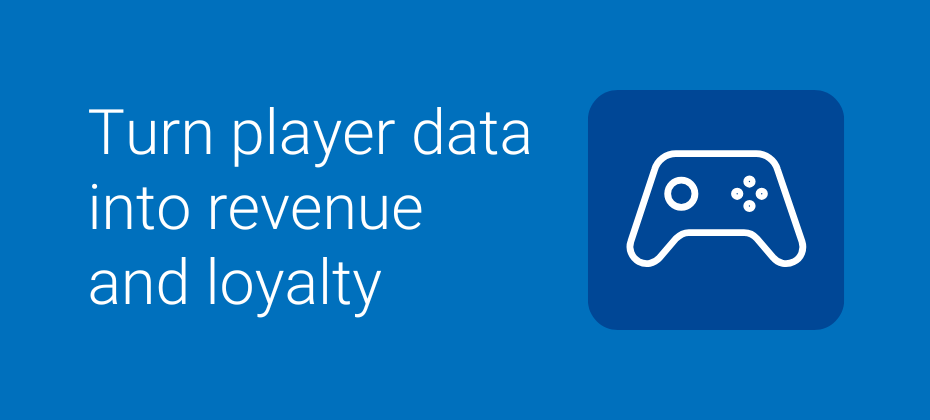
Gaming companies sit at a unique crossroads: they’re part entertainment powerhouse, part tech platform, part media company. Whether you’re publishing blockbuster titles, running a mobile game network, or building immersive in-game ad experiences, you have access to vast amounts of player data—and massive potential for growth. What's standing in the way of growth and loyalty Video game publishers and platforms are increasingly turning to data to understand, engage, and retain their players. But that’s easier said than done. Here are the top challenges they face: Data lives in silos. Gaming companies often collect data across multiple platforms—console, PC, mobile—but can’t stitch together a full view of the player across devices and titles. Identity is hard to resolve. Players interact across games, apps, websites, and platforms. It’s tough to connect all those signals and create a consistent, personalized experience. Privacy is non-negotiable. Regulations are tightening. Any solution must not only be powerful—it must be privacy-safe. Ad performance is difficult to measure. It’s often unclear which campaigns are driving engagement, conversions, or purchases—especially across fragmented digital touchpoints. How Experian can help you win with data and identity Experian helps gaming companies stop leaving value on the table. We turn scattered player data into a single, unified view—giving you the foundation to better understand and engage your players. Our approach: Organize, enrich, activate 1. We clean and unify your data We help you build a solid identity foundation by resolving messy, duplicate, or outdated records across systems. That means your player data from mobile, console, PC, and web all connects—giving you a clear view of how your users engage across games and platforms. 💡 How it’s working: A global interactive gaming company is partnering with Experian to unify and enrich player profiles across systems—boosting the performance of both player engagement campaigns and in-game monetization strategies. 2. We deliver deep customer insights With Experian, you go beyond surface-level data. We help you understand player behaviors, financial attributes, interests, and lifestyle factors—fueling more personalized experiences, smarter segmentation, and better monetization strategies. 💡 How it’s working: A major game developer used Experian’s data enrichment tools to gain deeper insights into player behavior and financial attributes—enabling more personalized in-game offers, smarter audience segmentation, and stronger player retention. 3. We enrich profiles and help you activate across channels We enhance your player records with hundreds of attributes—so you can create custom segments that work. Then, we help you activate those audiences in real-time across digital, social, and programmatic platforms. 💡 How it’s working: A global gaming publisher used Experian to build custom audiences and activate across programmatic channels, driving higher in-game engagement and ad ROI. Turning audiences into ad revenue In addition to improving their own player marketing, gaming companies are unlocking a second growth engine: ad revenue from non-endemic brands. Much like retail media networks, game publishers and platforms are realizing the value of their audience data. From airlines and automakers to QSR and CPG brands, advertisers are taking notice of the high-value, high-intent audiences inside game environments. But to attract that ad spend, publishers need to offer more than impressions—they need precise audience targeting, cross-device identity, and reliable measurement. How Experian helps drive better ad performance To appear authentically to a gamer, you need to know who they are and what they care about. Experian helps marketers understand a person’s behaviors and preferences to enable relevant, personalized advertising. And since nobody wants to see the same ad ten times during a session, we help manage ad frequency across devices and placements to protect the player experience. Our approach: Extend reach, measure results 1. We expand your digital reach Experian makes it easier to find and connect with your players wherever they are—across devices, platforms, and publishers. We help you build scalable audiences you can reach programmatically and with precision. 💡 How it’s working: Unity, a leading gaming platform, is redefining the way marketers reach their audiences across major and emerging channels. They’ve tapped into Experian’s syndicated audiences to gain player insights and help advertisers connect with gaming audiences across mobile, web, and connected TV (CTV) based on behaviors and preferences. 2. We help you measure what matters Whether your goal is app installs, in-game purchases, ad engagement, or player retention, we help connect the dots. You’ll know which campaigns are driving action—and where to double down. 💡 How it’s working: A leading global game publisher is working with Experian to enrich player profiles, build and activate audience segments, and measure how campaigns drive in-game engagement and purchases—giving them a clearer view of ROI across digital channels. Why choose Experian Whether you’re trying to build stronger player relationships or turn your audience into a high-performing advertising engine, Experian gives you the data and identity foundation to make it happen. We help you: Organize and clean your player data Resolve identities across digital touchpoints Enrich your data with deep, actionable insights Build and activate target audiences Measure impact across the player journey Let's power up together We’re already supporting leading brands across the gaming ecosystem—from global game publishers and mobile app developers to in-game ad networks and gaming platforms. And we’re ready to help more companies harness the full power of their data. Get in the game with us 🎮 Latest posts

As a programmatic media partner for marketers and agencies, MiQ’s mission is to ensure their clients’ media investments are spent on the right audiences in the right environments. MiQ needed a stronger way to unify audience insights, increase scale, and improve efficiency amidst signal loss. To meet this challenge, MiQ integrated Experian’s Digital Graph into their Identity Spine, creating a more comprehensive view of their clients’ target audiences and ensuring their data-driven solutions remain effective, regardless of the signal source or identifier in use. What is Experian's Digital Graph? Experian’s Digital Graph is like a puzzle, connecting billions of digital identifiers to create a complete view of consumers. As signal loss makes targeting harder, our Digital Graph helps marketers stay connected by linking cookies, mobile ad IDs (MAIDs), hashed emails (HEMs), IP addresses, connected TV (CTV) IDs, and universal IDs, like Unified ID 2.0 (UID2) and ID5. We put the pieces together, matching first-party data to a variety of digital IDs for better targeting, measurement, and cross-device insights—so you don’t have to. Challenge: Strengthen targeting capabilities amidst signal loss MiQ needed to stay agile in its strategy and partnerships to ensure digital connectivity amidst ongoing signal loss. To maintain campaign performance and scale, MiQ sought privacy-first partners they could integrate into their Identity Spine. MiQ’s primary objectives included: Strengthen audience targeting across all digital environments, with or without cookies. Reach target audiences in privacy-compliant ways. Maintain or increase the scale — even as reliance on cookie-based targeting declines. The solution: Integrating Experian's Digital Graph into MiQ's Identity Spine MiQ incorporated Experian’s Digital Graph, licensing HEMs, UID2s, and third-party partner cookies, into their proprietary Identity Spine. MiQ’s Identity Spine seamlessly connects over 60 cookieless data feeds and 25 ID solutions. “Experian’s Graph has bolstered our already comprehensive, multi-ID Identity Spine with incredible data on cross-device ownership and cross-channel behavior.”Georgiana Haig, Strategy and Partnerships Director, MiQ Results: MiQ expanded the reach and scale of their Identity Spine The integration of Experian’s Digital Graph with MIQ’s Identity Spine enabled marketers to find, grow, and measure customers across screens even as signal loss evolves and traditional identifiers fluctuate. The integration allowed MiQ to: Create a unified view: MiQ now has a unified view of its clients’ target audiences, enhancing their audience understanding with the addition of 6.5 devices to each matched IP address, enhancing scale and targeting capabilities. Increase scale: By matching first-party data to multiple universal IDs, MiQ expanded its reach across devices, contributing to a 51% increase in seed audience reach and and a 64% increase in reaching using universal IDs. Improve efficiency: The combination of Experian’s data with MiQ’s Identity Spine improved cross-device ID resolution, leading to more accurate measurement and reporting with a 70% match rate in associating MiQ-provided IP addresses with universal IDs. Stay connected to your audience despite signal loss with Experian MiQ’s Identity Spine stays strong through their partnership with Experian, keeping audience targeting effective even as signal loss changes the landscape. Download the full case study to learn more about how Experian’s Digital Graph enabled MiQ to strengthen audience targeting despite ongoing signal loss. Download the full case study Contact us About MiQ MiQ is a global programmatic media partner for marketers and agencies, with 19 offices across Europe, North America, and the Asia-Pacific region. They specialize in connecting data from multiple sources to solve business problems for their clients. They are award-winning experts in data science, analytics, and programmatic trading, focused on ensuring clients’ media investments are spent on the right audiences in the right environments. To learn more, please visit www.wearemiq.com. Latest posts

Summer may be vacation season for consumers, but it's go time for marketers. Between holiday weekends, travel season, and changing shopping habits, the pressure is on to deliver campaigns that land and convert. If you're feeling behind, you're not alone. Many marketers face the same challenge every year: How do you actually use the customer data you have to fuel high-impact, seasonal marketing? And how do you ensure your brand shows up in front of the right people in the right place before the competition beats you to it? That’s where Experian comes in. With Experian’s advanced Audience solutions, you can get ahead of the trends, connect with vacation-ready shoppers, and optimize performance across digital, TV, and retail media using customer data for seasonal marketing. Capitalize on vacation excitement to drive sales and growth Summer travel often triggers a surge in pre-trip spending. Surveys show that 82% of consumers plan to travel this summer, and according to Fortune, today’s travelers spend thousands of dollars on things like luggage, apparel, and recreation gear before they even leave their homes! But while consumer demand is heating up, so are the challenges. Marketers are navigating a turbulent economic environment shaped by shifting demand curves, tighter budgets, the rising cost of goods, and supply chain disruptions caused by newly imposed tariffs. These pressures are forcing teams to rethink everything from product positioning to pricing strategies. In this climate, it’s more important than ever to maximize performance, reduce waste, and stay laser-focused on reaching high-intent audiences likely to convert. Using customer data for seasonal marketing helps brands predict and capture demand with precise, relevant targeting. Whether your customers are planning a trip to the beach or hiking the Rockies, timely messaging and audience alignment can drive engagement and conversion. Experian Audiences power effective audience strategies But even the most compelling campaigns can fall flat if you're working with incomplete data, outdated segments, or generic targeting. Consumer data providers like Experian can help you fix that. Our Audience solutions help you go beyond assumptions and truly understand who your shoppers are, what they’re planning, and how they behave, so you’re ready to get in front of their summer plans. Six steps to creating a successful seasonal marketing campaign When you’re ready to turn summer intent into strategy, Experian Audience solutions help you translate vacation-driven behaviors into high-performing campaigns. Each product in the Experian Audience suite supports a specific stage in seasonal marketing planning and execution. 1. Define your goals Before diving into channels and creatives, get clear on your customer database marketing goals. Are you trying to increase online purchases? Drive in-store traffic? Expand brand awareness? Use Syndicated Audiences to set fast, focused goals. If you’re short on time, Experian’s 2,400+ Syndicated Audiences give you a head start. These pre-built, behavior-based segments — from luxury travelers to seasonal sports enthusiasts — help you quickly identify who to target, where they spend time, and how to message to them. With segments ready to plug into 30+ activation platforms, you can ensure quick, confident activation. 2. Decide what data you need and which audiences to target Using customer data for seasonal marketing means mapping behavior to intent. This core tactic in customer database marketing can help you drive deeper engagement. Our data solutions simplify the process, whether you’re starting with limited data or already know your best customers. If you’re starting with a list, Enrichment can append lifestyle, income, and travel preference data to help you understand what motivates your existing customers. If you don’t have a list, Marketing Attributes gives you full control when building new audiences or lookalikes based on relevant seasonal traits like beach vacationers or frequent CTV watchers. 3. Identify key holidays and events Summer is full of shopping triggers: Memorial Day, Father’s Day, Fourth of July, Labor Day, and countless local and regional events. However, not every customer behaves the same way. Use Enrichment to understand when your customers are most likely to act. By comparing your first-party data to broader market segments, you can time promotions more strategically. For instance, enrichment might reveal that outdoor gear buyers convert in early June, while luxury travelers plan closer to July. 4. Activate across digital, TV, and retail media Summer shoppers don’t stick to one screen. They’re streaming TV, reading travel blogs, browsing retail apps, and catching up on email — often from a beach chair or airplane seat. That’s why omnichannel delivery is a must, and it’s where consumer data vendors like Experian can help you reach your audience across channels with targeted messaging for key holidays and events: Syndicated Audiences simplifies omnichannel activation with built-in integrations to 30+ leading activation platforms. These pre-mapped segments let you deliver consistent messaging across the places where your audience is most engaged. Looking for privacy-forward reach? Contextually-Indexed Audiences are segments built by linking real-world behavioral data to the types of content those audiences typically consume online, allowing you to activate based on content instead of identity while offering a more contextually relevant experience. Using customer data for seasonal marketing, Experian maps real audience segments across web and app environments — like national park guides and travel blogs — for ID-free precision targeting in a cookieless environment. 5. Track and evaluate performance Don’t wait until the end of the campaign to make changes. Experian’s measurement tools help you track performance in real time, so you can optimize early and often. Measure how well specific audiences — enriched, syndicated, or contextual — are performing across platforms and use those insights to shift spend toward top performers. 6. Optimize and refine your strategy After the season ends, it's time to take what you’ve learned and build smarter for the next push. Use Outcomes to analyze: Who converted Which segments underperformed How your customer base compares to the broader market How your audience evolved Which campaigns drove meaningful adoption These insights can then inform your next round of audience building, so whether it’s back-to-school or a holiday, you’re already ahead. Example 1: The beach vacation shopper To illustrate Experian’s Audience solutions at work, let’s say a high-end swimsuit brand wants to reach women over 30 planning beach vacations to Florida, Hawaii, or Mexico. However, their CRM only includes basic transaction and purchase details and offers little insight into who their customers are. Audience solution: Enrichment Using Experian’s Enrichment solution, the brand could layer on lifestyle, income, and travel preference data to turn shallow profiles into rich audience segments. With a deeper understanding of their shoppers, the brand could develop a targeted messaging strategy by destination, build high-performing lookalike audiences, and confidently activate across channels. Example 2: The European traveler As another example, suppose a footwear brand wants to reach millennial travelers heading to Europe between May and August. They specialize in stylish, comfortable walking shoes that are ideal for travel but lack the technical in-house resources to build custom segments. Audience solution: Syndicated Audiences Using our Syndicated Audiences, the brand could easily tap into pre-built segments tied to leisure travelers, international shoppers, and comfort-focused footwear buyers. With plug-and-play access to over 2,400 verified audience segments, the brand could quickly layer this targeting into their programmatic and paid social campaigns without requiring custom development. And with fast speed-to-market and improved message relevance, the brand could launch cross-channel campaigns just in time for peak summer travel planning. Example 3: The outdoorsman Consider a camping tent company that wants to reach families planning summer trips to national parks, campgrounds, or RV resorts. They don’t have much first-party data to work with, but they know their audience is online, researching their next adventure. Audience solution: Contextually-Indexed Audiences With Experian’s Contextually-Indexed Audiences, the brand could target people actively reading content about outdoor travel (like hiking tips, campground reviews, or road trip itineraries) without relying on cookies or IDs. They’d be able to activate contextually relevant audiences mapped to sites that outdoor enthusiasts frequent and drive site traffic with strong click-through rates. Example 4: Big-box retailer launching summer gear Imagine a national retailer preparing to promote summer essentials like patio furniture, grills, fitness gear, and travel accessories. Their goal is to build predictive models for their summer product demand and reach new customers most likely to buy before they even search. Audience solution: Marketing Attributes With Experian’s Marketing Attributes, the retailer could license over 5,000 lifestyle, demographic, and behavioral variables to enrich internal models and uncover high-indexing consumer groups, such as outdoor entertainers or health-conscious families. This data-powered insight would help them predict demand and identify audience segments worth testing across media channels. The team could find new, qualified segments ideal for email and CTV activation and get a head start on the season, eventually increasing ROI on their summer campaign spend. Talk to Experian about your summer campaigns today Using customer data for marketing doesn't have to be overwhelming, especially when you have access to a trusted consumer data provider and plug-and-play audience tools for every stage of the funnel. Whether you’re working with a robust CRM or starting fresh, consumer data vendors like Experian can help you reach the right audiences with speed, accuracy, and confidence. Our advanced tools are designed for both advanced marketers and teams just beginning to explore consumer database marketing. No matter your goals, Experian is here to help you build an audience strategy that performs. Contact us today Latest posts